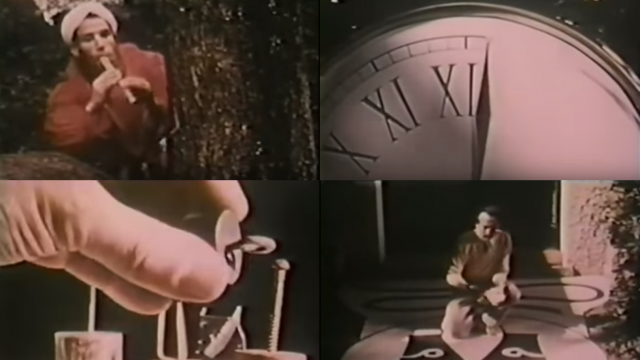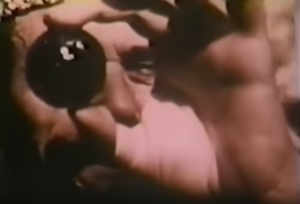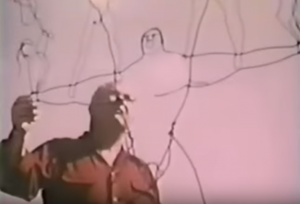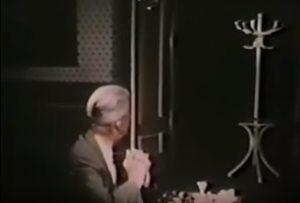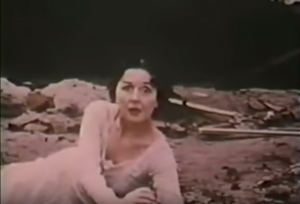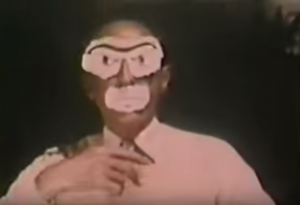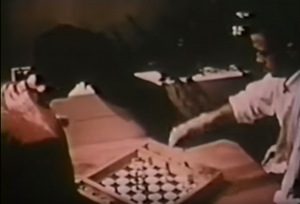This film deals with the world of fantasy. It is a fairytale for grownups.
– opening crawl of 8×8
The rules of the game are fixed. The pieces arranged by file and by rank. Eight lines. Eight times eight squares solidly framed on a board and set on a table… And yet, if everything, even what’s fixed, must sometime or other start moving, then why should the humble be patient forever?
I. Prelude
with Jean Arp
score by John Gruen
Two men play a quiet game of chess in the park until the chessboard, strapped as it is to the back of artist Jean Arp, decides to make a run for it. Pieces scatter on the ground, fall through sidewalk cracks, spontaneously ignite in the hollows below. A gloved hand reaches out behind a black and white door to grab at a self-propelling ball…
8×8: A Chess-Sonata in 8 Movements is a lark, a set of sketches directed by the grandfather of experimental film, Hans Richter, with a murderer’s row of artist-friends and a good bit of spare time. Its acting (all by non-professionals) is clunky, its themes are superficial, its organizational conceit is flimsy. Despite all this, or maybe because of it, 8×8 is a charming experience, like a home movie screening at the Pompidou, starring a full course’s worth of people you studied in college, none of whom are taking themselves seriously, most of whom are playing some variation on chess. Richter had been introduced the game by Duchamp, but claimed he didn’t have Duchamp’s killer instinct to master it. He’d initially planned a film about the Minotaur, but was “seduced”* into making a short, chess-themed film in his own back yard (chapter two’s “Black Schemes”) that so charmed his famous friends that they wanted to contribute their own episodes.
Richter cites Lewis Carroll and Sigmund Freud in the opening crawl, and both do cast a long shadow over the film. Games were important to the Surrealists for the ways they unlocked creativity – think of the Exquisite Corpse, for example – but they use chess here very differently than Carroll. Carroll’s use of chess has more in common with the Surrealist’s descendant-rivals, the form- and structure-obsessed Oulipo, in the way that both treat the chess match as a mathematical framework for organizing material. For Richter and company, chess is more of a tangle of deep myths, where each strand allows the artist to construct a different story, which is nonetheless the same story. “Chess is so universal,” Richter wrote to Cocteau, “that practically every human situation has its corresponding move among the countless possibilities of chess.”*
II. Black Schemes
with Jacqueline Matisse, Yves Tanguy, Julien Levy,
Marcel Duchamp,Richard Huelsenbeck,
Enrico Donati, and Nicolas Calas
score by Robert Abramson, lyrics by John LaTouche,
sung by Oscar Brand
8×8 is barely available in any format: we’re lucky that user Manufacturing Intellect has ripped a bad transfer to Youtube, which is much more than we’d have otherwise. The image is blurry and cut off at the edge, the colors are drained, and the sound is muffled with static. Somehow, this still feels like a perfectly fine way to watch this, home movie that it is.
Now, one typical difficulty in reviewing experimental films comes from reducing an experience designed to disorient to the banalities of observation (“This is what I saw”) and interpretation (“This is what it means”). Are either of those appropriate to this experience, or rather: what is the appropriate way to discuss a film composed of eight discrete and, apart from one metaphor, unrelated segments ranging from conventional to what-the-hell? In fairness, the film’s opening crawl invites both. The heavy stone in episode six represents the “daily burden”; the telephone in episode eight is “the demanding world of reality,” etc. This seems dissatisfying: are simple symbolic substitutions all there is to it?
The film’s original chapter, “Black Schemes,” doesn’t offer much of a counterargument, and is unfortunately the film’s longest and least interesting segment. The White Queen Jacqueline Matisse finds herself beset on all sides by Black Kings, Bishops, Rooks, and Knights played by a succession of thirsty surrealist artists. Some try to charm her (a hoary bit of slapstick from Black Bishop Yves Tanguy as a hypnotist who accidentally hypnotizes himself) while others use force, and in the best stretch, the Knight attempts a fantastic archery competition where the arrows that strike paper cutouts of the pieces also strike the real people they represent. All of this is mildly fun if overlong, and your enjoyment may depend on your tolerance for the interminable Abramson/LaTouche song that accompanies it (mine is… low).
III. A New Twist
with Alexander Calder
score by Hans Richter
Alexander Calder is one of many artists in 8×8 who worked with Richter on his previous film, Dreams That Money Can Buy (more on this later). Calder had written the “Circus” segment of Dreams, which features his mobile sculptures in motion against mostly black or muted backgrounds. In “A New Twist,” he himself becomes the focus, with Richter turning a quasi-documentary eye on Calder’s process of creation (tho not without certain tricks, like running the film backwards to watch Calder “unmake,” as well). But for a shot of Calder placing small sculptures on a chessboard, the film’s major motif is mostly absent here, as if the operator had queued a reel from a different movie.
With fewer composers involved in 8×8 (Dreams used most of 8×8’s contributors, plus others like Duke Ellington, John Cage, and frequent collaborator Darius Milhaud), Richter himself takes over here, layering everything from drums, horns, and modified vocal recordings to various kinds of mechanical noise — trains, automobiles, factories — against which Calder’s creations spin, jiggle, and wobble. All that noise is a blessed relief after “Black Schemes,” but it also helps highlight the idiosyncrasies of Calder’s art, like the interplay between hard, man-made materials and the natural and unpredictable flow of air.
Also, we get to see Alexander Calder playing maracas, so there’s that.
IV. Venetian Episode
with Ceal Bryson and Eugene Pellegrini
For all the immense talent involved in 8×8, its narrative segments tend to be disappointing in terms of theme and scope. Here, the White Queen Ceal Bryson finds a doll in the water that she pampers into a Pinocchio-style Real Boy. Her insistence on treating him like her puppet – dressing him in funny hats, forcing him to play chess with literal strings pulling his hands – eventually drive him to anger, and he smashes the board in protest. As his piece falls in the water, the Black Queen (also Ceal Bryson) scoops it up, and the devastated White Queen throws herself into the canal in despair.
The themes that recur throughout 8×8 are somewhat rote. Chess is a struggle between two opponents. Those opponents are usually male and female, thus King and Queen. The struggle unto death is indistinguishable from love, or at least the performance of love (i.e. courting). Freud reigns above. These ideas lie side-by-side, and sometimes in interpretative conflict, with the film’s other main concern, the struggle of the capital-A Artist against the banality of everyday life. Both Kings and Queens carry burdens, attempt to dance, yawn. The outside world rudely intrudes.
The act of making 8×8, the fact that it is a lark, is probably its best argument. It’s a middle finger to whatever the rest of the world might expect, with the typical puckishness of the Dada crew. Regardless of what you may want from your avant-garde bannermen, you’ll get an angry doll-man in funny hats.
V. The Self-Imposed Obstacle
by Willem de Vogel in cooperation with Hans Richter
with W. Sandberg
score by Hans Richter
Hans Richter directed two feature-length films while living in New York: the first, Dreams That Money Can Buy, is often cited as David Lynch’s favorite film. 8×8 was the second, and this is the first of its two chapters that showcase the kind of filmmaking we often associate with Lynch’s work. Here, Willem Sandberg finds himself unable to move his pieces because of a miniature coat rack (queen-shaped, made of pipe cleaner?) blocking their path on his chessboard. A full-sized coat rack looms behind him, an everyday object made terrifying, while mice crawl into his shoes and the soundtrack growls with sinister static and radio waves. I won’t spoil the ending.
While we’re here, it’s worth taking up the other part of the film’s subtitle: “A Chess Sonata in 8 Movements.” The term “sonata” is a flexible one in music history, and there are actually 8-movement sonatas from the Baroque period (an era greatly admired by the Surrealists, incidentally), but apart from directing our attention to the fact of music in the film, there is nothing formal or organizational about the term “sonata” that seems to apply to anything in the film. Terminology shared between the two media, like “theme” or “motifs,” tends to muddle rather than clarify formal comparisons.
Genre markers like these are usually used to underscore musicality rather than music, that is, the sense of flow, or scope, or whatever else the creator thinks is analogous but not equal to music (think, for example, of the City Symphonies of the 1920s, or the way high drama films are described as “operatic.”) From that perspective, the key feature of the sonata is its smallness, a work designed for a solo instrument or a small chamber ensemble, performed in a small room, for a small audience. 8×8 is for the living room, not the stadium cinema.
VI. Middle Game
after an idea by Dorothea Tanning-Ernst
with Max and Dorothea Ernst
partly shot by Elmer Purtymum
The “middlegame” is the critical centerpiece of the chess game. Openings are memorized, named, and studied. Endgames are the ultimate goal of strategy. The middlegame is where the players struggle to translate the former into the latter, arranging their pieces to lure, trap, and eliminate their opponent’s and thereby clear a path to the other king.
In “Middle Game,” the husband-and-wife team of Max and Dorothea Ernst play the Black King and White Queen, respectively. The White Queen pirouettes down an urban street carrying a heavy stone (her “daily burden”). The Black King steals it back to his hideout in rocky wasteland. The Queen travels there to find it, but it’s a trap! she’s lured into a landscape of war-torn rubble and pelted with stones by the conniving King. They reconcile (mate?), and the segment ends in Central Park at the statue of King Jagiello, swords crossed above his head.
The draw here is less the imagery than the sound design, which features otherworldly birdcalls in the city, jarring percussion in the rocks, sirens and explosions in the rubble, and a curious narrated text throughout. The latter creates a problem for interpretation, because 8×8 is a different film in the Information Age. Audiences watching “Middle Game” in 1958 heard a stream of narration that seemed to comment, if somewhat figuratively, on the action taking place: something about queens, kings, and the great game itself. Audiences in 2017, however, can paste a few of the phrases in a search engine and discover a pastiche of sources like the 13th century chanson de geste on Huon of Bordeaux, a tract by the 15th century Jewish poet Bonsenior Ibn Yahya, or the Burton translation of the Arabian Nights. The first two are so obscure that it might as well a private joke, since pre-internet audiences couldn’t possibly be expected to know these. This changes the nature of the game between creator and consumer, the former like a magician who no longer has mirrors to hide himself.
VII. Queening of the Pawn
produced and enacted by Jean Cocteau
score by Hans Richter
If chess players manage to advance a pawn, the weakest and least flexible of the pieces, to the end of the board, they are rewarded with a “queening,” the transformation of that pawn into the game’s strongest warrior. As the narration reminds us, a consequence of this rule is that both players may have several queens on the board.
“Queening” is 8×8’s strangest but most successful chapter, another segment that could easily serve as a spiritual ancestor of Lynch. And how to describe it in ways that don’t evoke the Black Lodge? The pawn-Cocteau drops loose pages across a stylish black-and-white floor, then the film is reversed and they fly back into his hands. He falls and un-falls. He tears pages, then un-tears them. Voices in French, English, Italian, and German recite the rules for “queening” as the audio is run backwards, then forwards, then backwards again. .draob eht no sneeuq lareves evah yam sreyalp htoB
This segment works so well because Richter coaxes these pieces into a satisfying experiential arc: after their initial individual statements, the voices are chopped into pieces, rearranged, sped up, slowed down, and finally layered into a rich polyphony of human language. (Richter himself called it a “fugue”* of words.) Against this babel, the pawn-Cocteau places his head inside a clock glass and emerges as a White Queen with a terrifying grin. Both players may have several queens on the board. Both players may have several queens on the board. Both players may have several queens on the board.
(The scenario was developed by Cocteau himself, who hurt his leg during filming. “If only I was able to fall in slow motion, the way the camera does it, but I can’t! Now my knee is aglow with all colors; that’s what you get from going along with the avant-garde: Technicolor’s Revenge.”*)
VIII. The Fatal Move
with Paul Bowles and Achmed ben Dris el Yacoubi
score by Douglas Townsend
“The Fatal Move” is preceded by the film’s best transition, a clock face whose numbers disappear as the hand moves across them, replacing them with the title on the second pass. It’s one of the many small touches that remind us of the enormous talent behind this little lark of a home movie.
So far we’ve had an opening and a middlegame, sacrifices and queenings… and now it’s time for the endgame. Paul Bowles lives in a swimming pool, trying his best to compose at the piano while the phone (“the demanding world of reality”) rings incessantly behind him. He becomes distracted by the mysterious sound of a recorder and finds a costumed Yacoubi hiding behind his mirror. They play beautiful music together, but Yacoubi escapes with Bowles’ suitcases (“all his earthly possessions”) when the latter is distracted once again by the phone. Bowles desperately searches for his lost partner, but the fatal move – the one play that has irrevocably changed the course of the game – cannot be taken back.
I don’t know if it’s fair to apply a queer lens to the action in chapter 8, given that none of the principles are (as far as I know) themselves queer, but the material certainly invites it. Yacoubi is one of the 20th century’s few multihyphenate artists who could just as easily have modeled for a men’s fitness magazine (here he is in 1956 with artist Francis Bacon), and his act of undressing is followed closely by Bowles’ longing gaze. As Yacoubi escapes in his underwear, the poet-musician is torn between the demands of his telephone and the beautiful man who got away. Yacoubi strips down not once but twice, the second time stealing Bowles’ clothes and taking his place. Meanwhile Bowles himself is absorbed into a tree, because this is that kind of movie.
The film ends as gloved hands emerge from the soil to aim what appears to be a wiffle ball at a solitary black king, knocking it down. Check and mate. Following the credits, a red balloon with the words “The End” is released to the sky, a weightless ending to a weightless film. But who needs all that extra weight, anyway?

